Check out our video review:
At this point I think it’s safe to say Diablo is a franchise that needs no introduction. According to the internet, the first Diablo is considered one of the greatest games of all time. I never played it in its prime but I remember seeing the game box in stores and people talking about it. I didn’t play it until years later when I bought the Diablo: Battle Chest which came with Diablo and Diablo II. But I couldn’t get into it for some reason. It was Diablo III that finally got me into the series and even the genre. I consider the first Diablo to be a landmark title in video game history. It’s not the first action RPG but it did pave the way for action RPGs as we know them today. Or to be more specific, Diablo is the the first loot-focused ARPG.
Developed by Blizzard North and published by Blizzard Entertainment, Diablo was released for PC in January, 1997 and Climax Studios developed the version for PlayStation which released in 1998. An expansion pack for the PC version called Hellfire was developed by Synergistic Software and released in November, 1997. For this review, I played the PC version and the expansion. I played the version released on GOG because it’s updated to run on modern systems and in the correct aspect ratio. I have played through Diablo before but I’ve been looking forward to jumping into the GOG release because of the updates and because it comes with Hellfire which I’ve never played.

The story is set in the town of Tristram. Years before the events of the game, Diablo, Lord of Terror, youngest of the Prime Evils, was imprisoned in a soulstone that was buried deep in the earth below a monastery. Some time later Tristram sprang up near the monastery which fell into ruins and a cathedral was built over top of it. After Diablo manipulated an archbishop to free him from his soulstone, Tristram became a town of fear and horror. The story begins when the protagonist arrives in town with the goal of descending the labyrinth beneath the cathedral and slaying the evil within. The Hellfire expansion doesn’t alter the plot but it does come with its own storyline that occurs as an aside to the main story arc. A sorcerer unknowingly releases a demon unto the town but then seals it before it can completely escape and the protagonist is tasked with vanquishing it.
Diablo aims for a dark and gritty tone and I love the game’s sense of progression. As you descend the labyrinth under the cathedral, the environments change and become more “hellish” for lack of a better word. There’s actually multiple settings. The first set of floors reflect a standard dungeon environment, then comes the catacombs, caves, and finally Hell itself and Hellfire comes with two new dungeon settings; nest and crypt. Furthermore, the enemies you face become more dangerous the further down you go. The early floors pit you against a lot of undead foes and by the time you get to Hell, you’ll be up against demons and other monstrosities. I like this sense of progression, the concept of delving into more evil environments. It fits well with your character’s progression in terms of becoming more powerful as you progress.

Before getting into the nitty gritty, I just want to go over what this review will be. In today’s world, I think it’s safe to say that many players are familiar with Diablo and its brand of gameplay, familiar with action RPGs like this in general. That said, I will still be going over mechanics that can be considered staples of the genre. Also, I’m aware of Diablo’s age and status as the first of its kind so some of my criticisms may seem a bit unfair. However, I will say I can forgive most of them. I’m still going to point them out, though. I just feel some things haven’t aged well and are harder to ignore today. Part of the reason is the sequels and other games in the genre that have released since Diablo have changed, rectified, and streamlined some things for a more enjoyable experience. If this was 1997, my final thoughts on Diablo would be something like this, Diablo is an incredible game with addictive gameplay and endless replayability. It was innovative for its time and kicked off a new subgenre. But this review is basically going to cover what it would be like to play the game today keeping in mind its age, status and legacy. So if you don’t like that idea then I advise you to stop reading now.
The protagonist of Diablo is your character. Before jumping into the gameplay, the player must choose their character class and then name the character. The classes include the Warrior, Rogue, and Sorcerer and Hellfire adds in the Monk class. Each class comes with their own skill and different starting values in strength, magic, dexterity, and vitality. Diablo is a game that can be played solo or with others. In the base game, there are no difficulties to choose from in single player. So all single player characters are on the Normal difficulty level but harder difficulties are available in multiplayer. Hellfire permits single player characters to access the harder difficulties. For this review, I played through the base game and Hellfire in single player. I didn’t get the chance to check out the multiplayer. I chose the Warrior for my base game playthrough and the Rogue for my Hellfire playthrough. As a side note, I want to mention that despite the multiple floors under the cathedral where most of the game takes place often being referred to as a labyrinth of different settings, I’ll be referring to it as a whole as “dungeon” just to keep things simple.

Diablo is primarily played by pointing and clicking. You point and click around the screen to move your character and interact with things. To move, to attack, to access your inventory, spells, and stats – it’s all done by pointing and clicking. But there are shortcut keys you can press to quickly access certain things. The town of Tristram is like a hub area. This is where you can interact with NPCs, buy and sell items, accept quests, and access the entrances to the different dungeon floors. The town is also where one of my criticisms lies. In the base game, you can run or jog in the dungeon but not in town. Your character is forced to slowly walk around town and it makes getting around tedious. Hellfire comes with the option to jog around town which actually makes it look like your character is moving in fast forward but it is one of the best features of the expansion.
Diablo can be considered a dungeon crawler. The dungeon beneath the cathedral consists of sixteen floors and each one is designed to be more difficult than the last. One of the most unique features of the game is the randomization. Every time you start a new game, the dungeon floor layouts, quests, and loot are randomized as is some of the enemies that appear. This adds a lot of replay value to the game because no playthrough will ever feel the same. Loot is a big part of the game. It’s what makes the experience fun and addictive. Slaying monsters and finding new toys to play with. The toys being loot. Loot is basically all the items in the game. Gold, weapons, armor, jewelry, potions, elixirs, spells, scrolls and if playing Hellfire; oils and runes. Loot can be found in the environments and enemies will often drop loot when defeated.
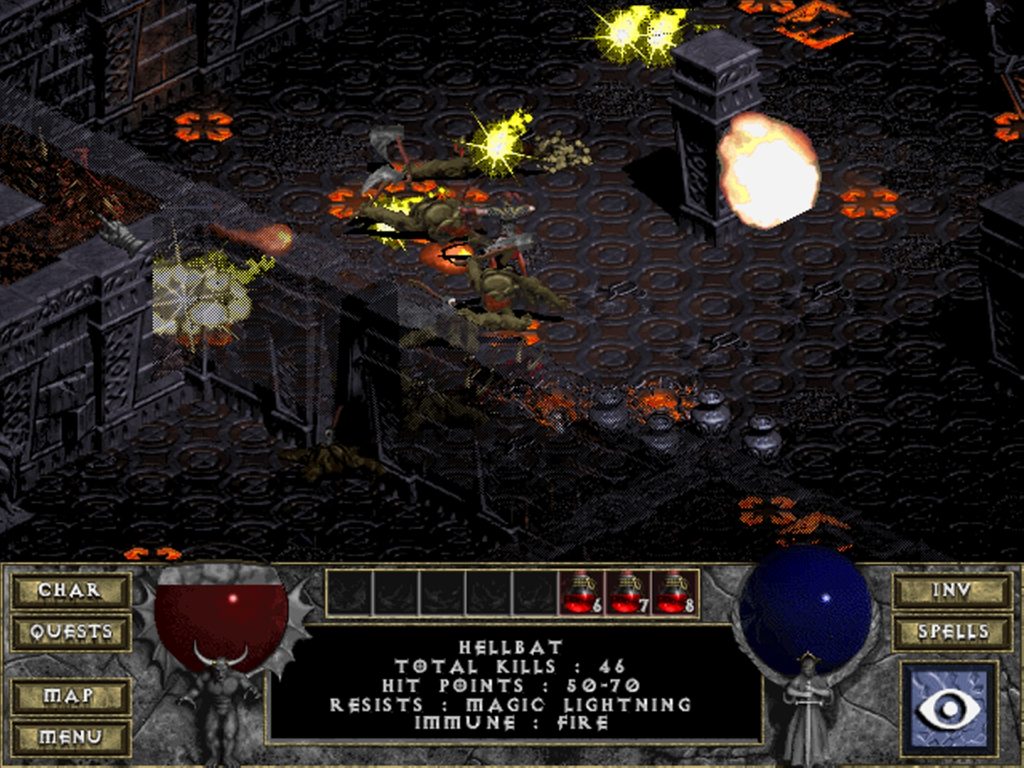
Weapons, armor, and jewelry or equipment can be magical which basically means they come with special properties. Properties like inflicting more damage, better armor, a boost to your character’s stats, and some will even grant resistance to elemental attacks, among other things. Items like these typically need to be identified for the properties to be revealed. It’s always wise to keep an eye on your weapons and armor because they can break after a while but the blacksmith in town can repair them for a fee. The Warrior comes with the repair skill so he can repair items but it reduces durability. Hellfire comes with a bunch of new loot and oil is one of the new types. Oils can be used on equipment to boost their stats like damage and durability. Another new type is runes which can be placed as traps for enemies.
The game’s formula is pretty simple. Slay monsters, earn experience, level up, equip better gear, rinse and repeat until you defeat Diablo. As you slay monsters, you earn experience and when you earn enough, you level up and are awarded points that can be spent to improve your character’s stats or attributes. While character building isn’t as deep as that of the sequel, it is important to know the strengths and weaknesses of each class and allocate points appropriately. There’s all kinds of weapons and armor that you can find and equip and spellbooks that can be read to learn new spells. Items like these will require your character to have a certain amount of points in certain attributes before they can be equipped or read. Whenever you take damage, you lose health and whenever you cast a spell, it drains your mana. These can be replenished by potions and even by things like shrines found in the environments. Health can also be replenished by the healer in town.
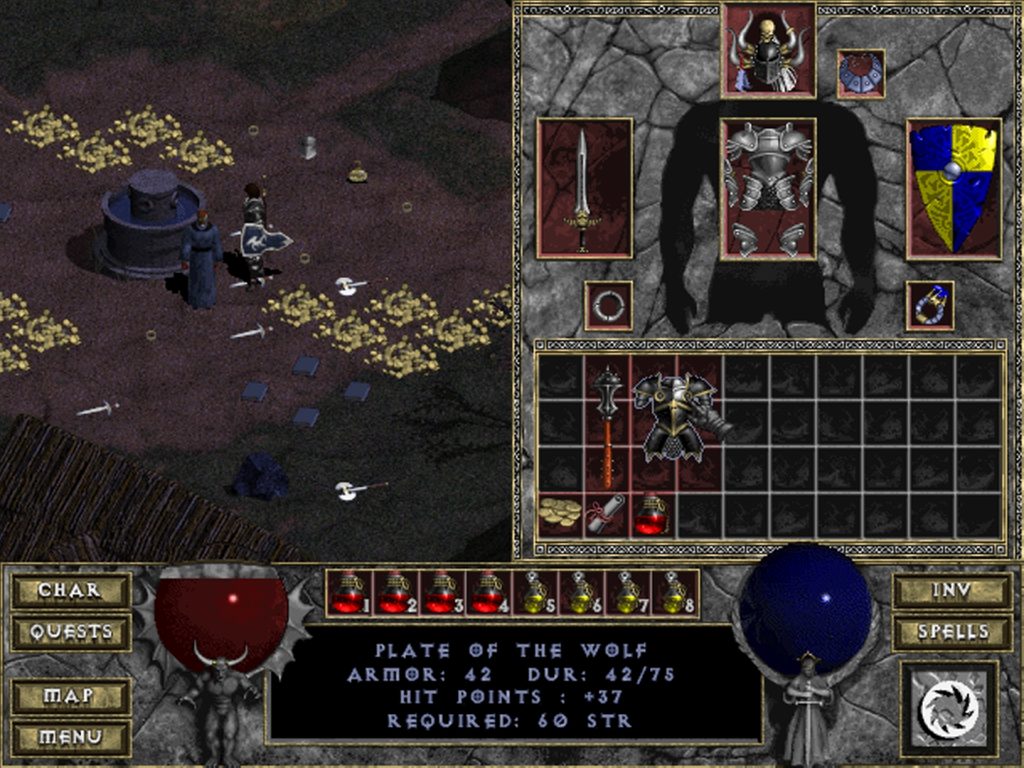
There’s not a lot of options for farming experience. At least not without starting a new game. Enemies do not respawn so it’s wise to explore every floor fully and clear out all the monsters before descending to the next floor. You can start a new game with an existing character at any time but depending on what level your character is, it may take time before you start gaining noticeable experience again. For example, in single player with my Warrior, I reached floor fifteen and was struggling with some encounters so I decided to start a new game with that same character. I breezed through most of the floors but didn’t start gaining any noticeable experience until I reached floor nine and didn’t actually level up again until floor thirteen. Starting a new game also comes with other advantages like being able to farm gold and access new or different loot. What does this all mean you ask? It means allocating points appropriately and equipping the right gear is important if you want to get through each floor without too much frustration.
Now I’m going to go over some things that I feel have been improved in the sequels and even other games in the genre. For starters, if you don’t have the town portal scroll or spell, backtracking to the nearest exit can be tedious. As you progress, you’ll unlock entrances to certain floors which also double as exits but it’s still wise to ensure you can open a portal back to town. Second, your character doesn’t have a lot of inventory space and gold takes up inventory slots. Hellfire comes with an amulet that doubles gold capacity but I feel this should have been a permanent feature. Also, loot can sometimes be hard to see in the environments. Hellfire comes with a Search skill and spell and once cast, it highlights loot on the ground for a limited time. I feel this should have also been permanent or maybe just an optional feature like jogging in town.
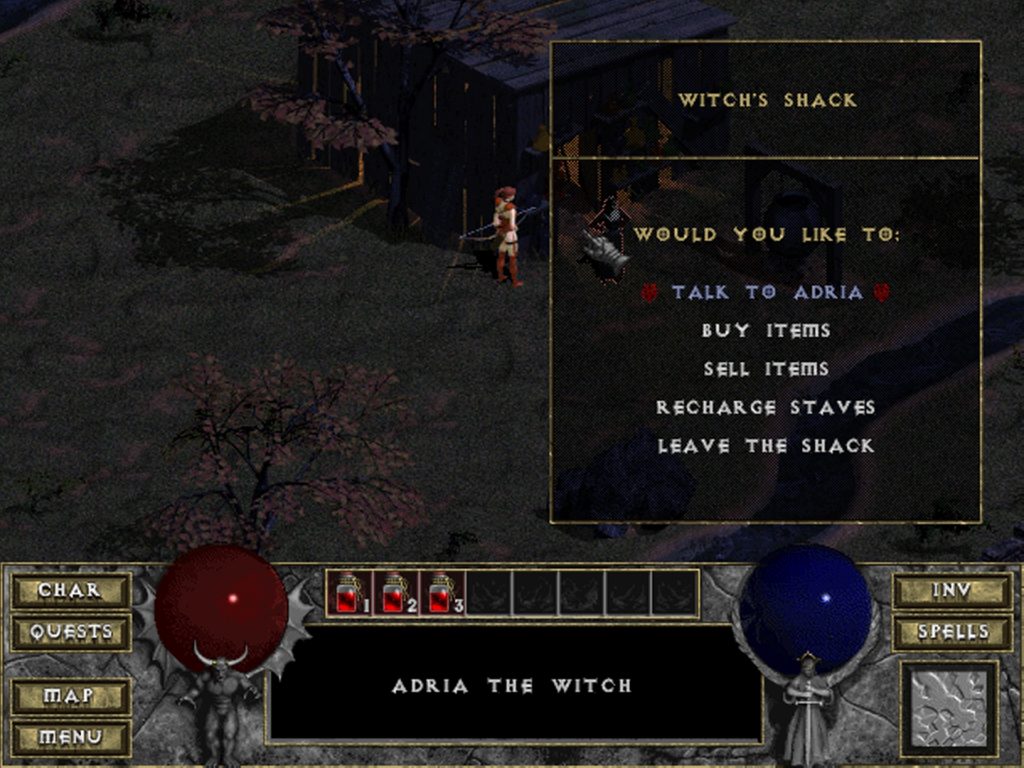
Another thing to note is that there’s no stash chest for you to store items in so if you want to save anything for later or for certain enemies or situations, it’s best to drop the items on the ground in town like some kind of litterbug asshole. In the base game, you can’t transfer items to another character in single player but you can in Hellfire. The feature is called Cornerstone of the World. In the crypt, you can always find a room with a stone or the Cornerstone of the World and an item dropped on this stone can be retrieved by a different character.
Your primary objective on each floor is to locate the stairs to the next floor. Enemies or monsters populate each floor and every now and then you’ll come across a unique or stronger monster than its standard counterpart and some quests lead you to what you might consider bosses. All quests are basically optional and many are given by NPCs in town but some are offered by NPCs found in the dungeon. What makes the quests worth completing is the rewards. Special loot (if you will) not found by normal means. The quest objectives are pretty simple. Things like slay specific enemies and retrieve items. Only a small number of quests always appear in every playthrough, the rest are randomized. So one playthrough may offer the quest to cleanse Tristram’s tainted water source but the next playthrough may not. Once you accept a quest, you’ll have to find the exact location of your objective which is typically on the floor you’re currently on or the next one. Some of the items you receive as rewards are better for certain classes so you can always start a new game in hopes of getting the quest(s) you want.
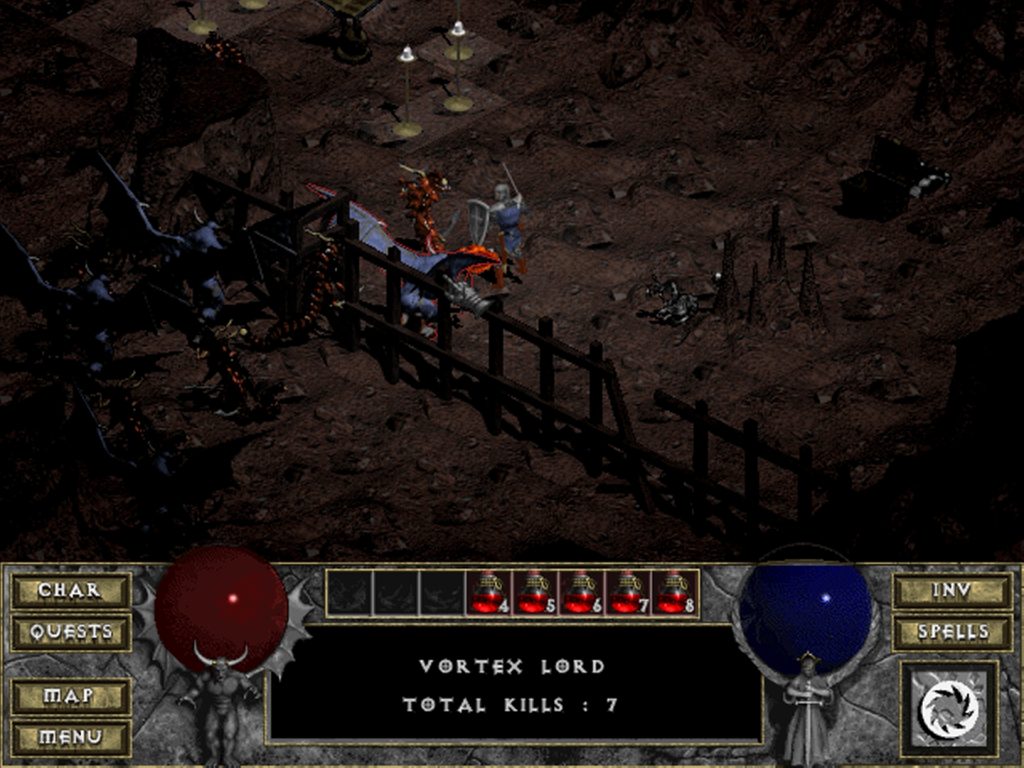
The dungeon floor layouts may be randomized for each new game but you will see some of the same rooms or room designs in each playthrough. Most floors consist of numerous rooms connected by doors. Chests and other containers and breakable objects are littered about and can contain loot but you need to be careful because they can also be traps. At the press of a button, you can bring up the automap to see where you’re located and what parts of the floor you have revealed which is convenient. For the most part, I would say Diablo puts up a fair challenge. However, some of the later floors can be frustrating mainly because the mobs that appear can be very annoying. Any mobs of enemies that unleash projectiles can be aggravating if you’re not properly prepared and equipped. I did better with the Rogue in Hellfire, I’m guessing because the gear I had equipped resulted in better resistances to certain elemental attacks. In both playthroughs, I found it wise to use corners and doorways to manage mobs. Basically, forcing enemies into a bottleneck seems to be a good strategy. Regardless, even with allocating points appropriately and the right gear, some enemies and mobs can still lean towards the side of frustration.
As for the presentation, I do like Diablo’s art style and the dark and gritty tone it conveys. The character and enemy models look good, the animations are solid, the environments are well detailed, and the different dungeon settings make for a good amount of visual variety. I also feel the gore effects help make kills feel satisfying. Enemies will grunt, groan, and scream and the sounds of strikes and hits get the job done. The action is backed by a great soundtrack with a mix of memorable and ominous tunes that really help drive the dark and creepy atmosphere. On the technical side, I did not encounter any issues.
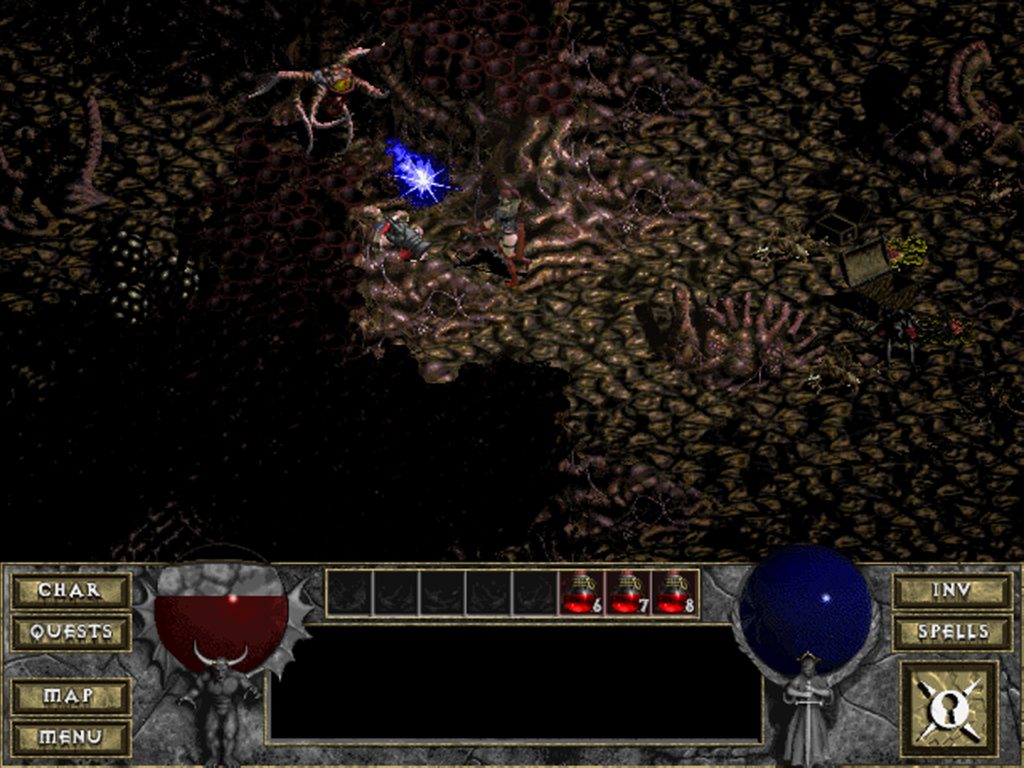
I had a great time with Diablo but I admit that in today’s world, it’s not my favorite game in the genre. I think the formula and mechanics and have been improved in the sequels and other games. Nevertheless, I do feel Diablo still holds up rather well. If you’re familiar with more modern games in the genre and decide to jump into this, you’ll undoubtedly notice the lack of some quality of life features. Diablo definitely shows its age in many respects but I feel the gameplay is still fun and the replay value it offers ensures every playthrough will feel different. I also feel there’s a nice simplicity to it. The sequels and other games have added so much to make the formula and gameplay deeper and in that regard, I do think Diablo is more accessible. You don’t have to worry about pumping points into skills and finding, equipping, and crafting the exact right gear to give you the benefits needed for maximum damage, armor, and/or resistance or to maximize certain skills. Diablo has no runewords, set items, sockets, gems, or crafting of any kind. But don’t get me wrong, you should still know the strengths and weaknesses of your character’s class, allocate points appropriately, and equip the proper gear.
Basically, I feel Diablo is easy to jump into and the mechanics are easy enough understand that you shouldn’t hit a wall in terms of character building. I also feel the Hellfire expansion is the best way to experience the game. It simply adds more. More features, more items, more dungeon settings, more quests, more monsters, and an additional character class. This is the first time I played through the expansion and in my opinion, it’s an overall improvement. Being able to quickly get around town is probably my favorite thing about it. Everything it adds is simply integrated into the game and doesn’t interfere with anything offered in the base Diablo experience. That means you can avoid most of Hellfire’s exclusive content like the new quests and floors for example if you so desire.

I absolutely recommend Diablo. This is one of those must play games if you’re a fan of the genre. I consider it a classic and landmark title in the world of the video games and I do find it fun to revisit every so often. It can be enjoyed solo or with others and there are some cool mods for it out there, too. It is the first of its kind so it definitely shows its age but I still feel the gameplay holds up well and most importantly, it’s still fun to play. Definitely check it out.
